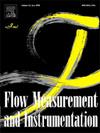Microwave measurement method for water holdup in horizontal oil-water two-phase flow
IF 2.7
3区 工程技术
Q2 ENGINEERING, MECHANICAL
引用次数: 0
Abstract
Horizontal oil-water two-phase flow, a prevalent phenomenon in petroleum production systems, requires precise water holdup measurement for effective reservoir monitoring and enhanced oil recovery optimization. To address the complex flow structures characteristic of horizontal wellbore conditions, this study introduces an innovative measurement approach utilizing a coaxial microstrip antenna sensor. The experimental methodology combines 13-channel parallel-wire conductance probes (PWCPs) with quick closing valves (QCV) for accurate water holdup calibration. Flow pattern identification is achieved through a radial five-channel conductance probe system, which distinguishes three fundamental patterns: stratified flow (ST), stratified flow with mixing at the interface (ST&MI), and dispersion of water in oil concurrent with oil in water (D W/O&D O/W). The research further establishes a flow pattern-based physical model for effective dielectric constant determination in oil-water systems, enabling reliable water holdup prediction. Experimental results demonstrate the method's strong performance across a broad water cut range (21.88–98.04 %), with an absolute average deviation (AAD) of 0.03 and absolute average percentage deviation (AAPD) of 5.57 %, confirming the technique's accuracy for industrial applications.
水平油水两相流含水率的微波测量方法
水平油水两相流是石油生产系统中普遍存在的现象,为了有效监测储层和提高采收率,需要精确的含水率测量。为了解决水平井筒条件下复杂的流体结构特征,本研究引入了一种利用同轴微带天线传感器的创新测量方法。实验方法将13通道并联导线电导探头(PWCPs)与快速关闭阀(QCV)相结合,用于精确的持水率校准。通过径向五通道电导探头系统实现流型识别,该系统可区分三种基本流型:分层流(ST)、界面混合分层流(ST&;MI)和油中水同时分散(dw /O& do /W)。该研究进一步建立了一个基于流态的物理模型,用于有效确定油水系统的介电常数,从而实现可靠的持水率预测。实验结果表明,该方法在较宽的含水范围(21.88 ~ 98.04%)内具有较强的性能,绝对平均偏差(AAD)为0.03,绝对平均百分比偏差(AAPD)为5.57%,验证了该技术在工业应用中的准确性。
本文章由计算机程序翻译,如有差异,请以英文原文为准。
求助全文
约1分钟内获得全文
求助全文
来源期刊

Flow Measurement and Instrumentation
工程技术-工程:机械
CiteScore
4.30
自引率
13.60%
发文量
123
审稿时长
6 months
期刊介绍:
Flow Measurement and Instrumentation is dedicated to disseminating the latest research results on all aspects of flow measurement, in both closed conduits and open channels. The design of flow measurement systems involves a wide variety of multidisciplinary activities including modelling the flow sensor, the fluid flow and the sensor/fluid interactions through the use of computation techniques; the development of advanced transducer systems and their associated signal processing and the laboratory and field assessment of the overall system under ideal and disturbed conditions.
FMI is the essential forum for critical information exchange, and contributions are particularly encouraged in the following areas of interest:
Modelling: the application of mathematical and computational modelling to the interaction of fluid dynamics with flowmeters, including flowmeter behaviour, improved flowmeter design and installation problems. Application of CAD/CAE techniques to flowmeter modelling are eligible.
Design and development: the detailed design of the flowmeter head and/or signal processing aspects of novel flowmeters. Emphasis is given to papers identifying new sensor configurations, multisensor flow measurement systems, non-intrusive flow metering techniques and the application of microelectronic techniques in smart or intelligent systems.
Calibration techniques: including descriptions of new or existing calibration facilities and techniques, calibration data from different flowmeter types, and calibration intercomparison data from different laboratories.
Installation effect data: dealing with the effects of non-ideal flow conditions on flowmeters. Papers combining a theoretical understanding of flowmeter behaviour with experimental work are particularly welcome.
 求助内容:
求助内容: 应助结果提醒方式:
应助结果提醒方式:


